
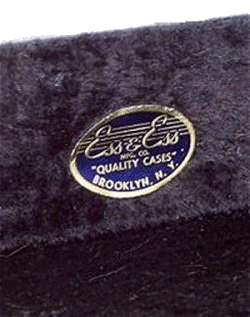
|
Regardless of whether it was an acrylic guitar or bass, every Dan Armstrong · Ampeg
instrument could be ordered with a custom hardshell case for an additional $60.00 as per literature quote
of June, 1969.
These hard shell cases were manufactured and supplied by the Ess&Ess Manufacturing Company out of New York who were a
major supplier of cases for many musical instruments on the market. Ampeg contracted them to build form fitted cases
for Dan's new line of instruments.
If it hasn't been removed or worn away one can usually find the Ess&Ess tag up by the headstock portion of the case on
the inside liner. Their sticker advertized them as the Ess&Ess Mfg. Co. Quality Cases, Brooklyn, New York.
|
When Dan and I got around to talking about the cases for the acrylic instruments I remember asking him how it was that
he chose Ess&Ess over other makers. Dan replied "It was a matter of convenience more than anything else,
I knew someone in the area had to be making guitar cases so I just asked around. When I finally got their name I just
turned the contact information over to Ampeg and let them handle it from there, I really didn't have much to do with
it."
But a second later Dan added "I do recall that we decided to only make the one size case, and someone took a bass
over to them [Ess&Ess] so they could get body and neck measurements as trying to do it over the phone was
quite a hassle." I then asked why only one size case was made and Dan went on to say "Convenience again, plus
just plain economics. The dimensions of the guitar and bass bodies are the same, and it was cheaper to just make one
case. The bass has the longer neck - so the case was designed for it, but we also made sure the guitar neck was
going to be supported too."
As seen above left, the Ess&Ess case is a perfect fit for the bass guitar but as seen above right, it cradles the
guitar body equally well since the body dimensions are the same. Although the neck is shorter on the
guitar model, it is still supported. Although fairly dark, the cross member of the case that supports the neck can be
seen at the 3rd fret - whereas it's at the 5th fret area on the bass guitar.
Above left, the case is form fitted to hug the acrylic body while at the same time supporting the neck. By
cradling the body in this manner, the neck is more isolated from any jarring or shock. The pickup compartment is large
enough to house at least four pickups as well as a strap and other accessories. A metal hook helps to ensure that the
lid to the pickup compartment remains closed.
At right, the supports and padding of the Dan Armstrong case can be seen better. The headstock is kept clear of the
bottom of the case by a padded support piece that extends the entire width of the case and is located at or very near
the third fret area on the neck. The inside cover of the case features a piece of padding located directly above this
area which in turn keeps the headstock clear of the topside of the case as well. Further back more padding can be seen
on the inside cover, helping to secure the body when the lid is closed. Watchful eyes may have noticed that there is
also some additional padding located in the position between where the two strap pins on the body would lie. The bottom
of the case is slightly raised and padded in the body area so as not to create any pressure on the point where the neck
and body come together. In essence, the case itself is a total shock-mount design made to support, cradle, and protect
the body and neck during transport.
At left is an earlier production run of cases. While still made by the Ess&Ess Mfg. Co. these cases are virtually
identical to the other cases shown above, with a few exceptions. As can be seen above left, the lid to the pickup
compartment faces, and thus opens the other way compared to the former style case. The lid itself is kept closed by a
small piece of leather that snaps to the lid itself vs. the metal eyelet & hook combo of the former case. As can be
seen upper right, these cases sport a different shaped carrying handle as well. The shape of the handle is more squared
off and features a strip of metal covering the section where the the handle anchors to the case - whereas the former handle
is more rounded in shape and secured to the case differently.
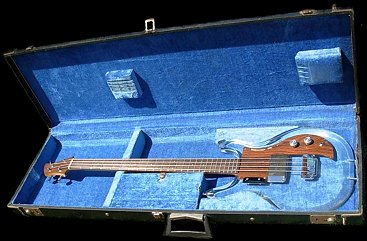
|
The very early cases featured a light blue velvet-like liner inside - as can be seen at left. Notice too, that this
case also employs the squared off handle and the reverse lid on the pickup compartment that features the small strip
of leather with a snap.
In addition to the changes in the handle and pickup compartment was the change of color for the velvet type liner.
Soon all inner linings would be available in black only. While the other colors may be valued a bit higher due to
their rarity, I have always liked the black liner inside the case as I feel it is a nice touch that looks classy and
was (and still is) a welcomed relief over the loud and gaudy colors that are so prevalent in other cases.
|
Why Ess&Ess chose to supply two different style of cases for this line of instruments is both confusing and unknown
but it's a good bet that it was one of two reasons. The first reason may have been that there was a shortage of the
aforementioned parts and they needed to get cases out the door, so they substituted with different handles, latches
and inner linings.
Since the early cases are the ones with the different hardware and colored linings inside and, since both of these
seemed to have been changed in and around the same point in time would seem to suggest another reason, or theory which
was that their vendors had changed their product lines to the parts and colors that we all know.
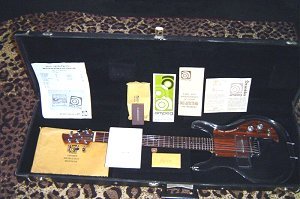
|
The guitars and cases all included what players today refer to as 'case candy'. Brochures, literature, and any
accessories that might accompany an instrument. At the upper left is a string advertizement page, then an extra pickup and it's protective
package, an Ampeg amp & accessories brochure, the owners manual, and an Ampeg Scrambler® effects unit advertizement. On top the pick
compartment is the case keys and truss rod adjuster (in envelope), owners registry card, and a large folder type envelope to hold everything.
|
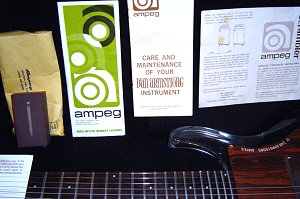
|
A little more closer look at some of the Dan Armstrong/Ampeg case candy. The registry card, pickup, and the care & maintence brochure
guide can be seen on other pages on this site. More pages will be added as they become available. The Scrambler was a
distortion/octave pedal. Seen here, on the left page is a drawing that describes using the Scrambler unit in a 'Y' type
configuration - using two Ampeg amplifiers.(notice the logo on the upper left corner of the amplifiers' speaker cabinets)
|
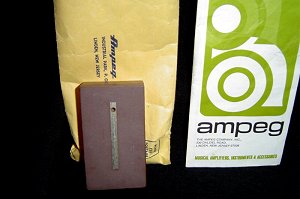
|
Another brochure that accompanied the instruments is the Ampeg musical amplifiers, instruments, and accessories
brochure, seen at left. The backside of a Dan Armstrong pickup can be seen resting against it's protective package.
Notice the threaded screw hole for the guitar's thumb screw to turn into and secure the pickup to the body. Behind the
pickup, notice the pickups protective yellow mailer type package. In particular, notice the postage amount needed back
then if one were planning to mail it.
|

|
While the Ess&Ess Mfg. Co. would survive the passing of the Dan Armstrong instruments, it would not endure
indefinitely.
As Matt Umanov states "Ess&Ess was owned by the Sandler family, and was located I think in the
Bushwick neighborhood, maybe on Bushwick Ave. We used to do business with them directly years ago. The company was,
during the 1970's or early 1980's, taken over by the son, Marty Sandler and eventually they went out of business
sometime in the mid-1980's at the latest, not to be revived in any way, by name or otherwise."
The photo at left shows the Ess&Ess Mfg. Co. which was located at 95 Grand Ave. - Clinton Hill, Brooklyn, NY.
Today, these cases are somewhat sought after and - given their rarity - the presence of an original Ess&Ess case
greatly increases the value of a Dan Armstrong · Ampeg guitar or bass. About the only way to
acquire such a case is through the various online auctions, &/or select guitar shops.
|
menu
Names and images are TMand © Dan Armstrong / Ampeg. All rights reserved.
All other names and images are TMand © of their respective owners. All rights reserved.
|
| |

